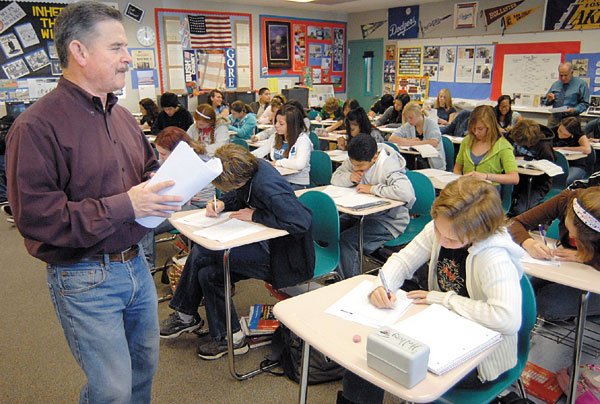Solorsano Middle School Team Earns a State Honor; Increased
emphasis on data analysis beginning to pay off
Gilroy – While Solorsano might be getting the Distinguished School Award in May, the improvements that earned it the honor are echoed in other middle and high schools and point to the district’s emphasis on monthly testing and teacher collaboration, teachers and district officials said.
During the two school years since 2004 – as the use of regular, in-school testing to assess students and design lesson plans became widespread in the district – the three middle schools and the high school in the Gilroy Unified School District posted significant gains on state-administered tests that measure how much students have learned over the course of a year.
Together, the four schools exceeded their expectations for increased student performance – also known as student growth – by triple and outperformed similar schools by nearly 50 percent.
Teachers at Ascension Solorsano Middle School, which led the Gilroy pack in student gains and is in line to get two awards this year for its performance, say the success is primarily the result of using data to discover student weaknesses and address them.
“We teach and we test and we look at the test results,” said Pat Kloecker, a Gilroy native who has taught in the district for 22 years and has been with Solorsano since it opened in 2003.
This testing – coordinated in timing and content across classes and grades – allows teachers to identify student weaknesses and concepts that the whole class did not get. Semi-weekly meetings with other teachers then allow staff to identify department-wide and school-wide shortcomings.
Because teachers who are having trouble teaching a concept have access to the results of other classes in these meetings, they can identify fellow teachers who are having success teaching that concept and ask them for advice.
“People really set aside their egos and say ‘help me,’ ” said Tricia Satterwhite, an English teacher with 15 years experience and who was one of the seven original teachers to help Solorsano open its doors.
Teachers are also setting aside more time as the new system demands several more hours each week to converse with fellow staff members and extra hours at home to design lesson plans and tests that address concerns highlighted by data.
This willingness to improve and spend time improving has been a cornerstone of the progress over the past few years, as teachers battled to gain a hold on the new process of collecting and analyzing data.
“At first we gathered data we really didn’t need,” said Kloecker. “We’re learning as we go-what do we want to collect? What’s going to give us our most bang for our buck?”
The teachers were aided in this struggle by the addition of computer software that compiles the data and organizes it.
Before the software, “We were literally going through list of students and highlighting,” said Pat Midtgaard, a former principal in the district and now a member of the board of trustees. “I mean, totally going through it by hand.”
The software was but a small manifestation of the overall sea change in the district’s view of collaboration in the past decade.
In 1994, when Midtgaard was head of Eliot Elementary School, she was reprimanded for sharing the school’s test scores with her teachers. Now, schools not only share scores with members of their own institution, but also with other schools and their teachers.
Despite the changes in district opinions and rise in student growth, proficiency levels in math and English at many schools remain low. Three out of the four secondary schools in Gilroy were sub-standard in one or both of these categories in 2005-2006.
These benchmarks will be reached in time, said John Perales, principal at South Valley Middle School.
For now, “It’s about movement,” he said. “Are the kids getting better.”
In time and with continued hard work, student gains will result in proficiency, Perales said. The teachers in Gilroy, given the current system, will get the job done.
“When you come around as a group, you end up with a sum that’s more than the parts,” he said. “I don’t think it’s a secret. It’s a lot of hard work.”












